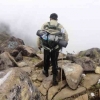It seems that every country cannot completely avoid natural disasters. Including Indonesia, a country that incidentally experiences natural disasters quite often. Throughout 2021 alone, Badan Nasional Penanggulangan Bencana (National Agency for Disaster Countermeasure) recorded around 2,500 natural disasters that occurred on the mother earth. Starting from flash floods in South Kalimantan, landslides in Sumedang, earthquakes in West Sulawesi, and most recently, the eruption of Mount Semeru in Lumajang, East Java. There were also casualties. In certain cases, the evacuation of victims of natural disasters can be very complicated. For example, victims can be difficult to find because of the condition of the ground that has been destroyed by landslides and earthquakes. Or, when found, the condition of the victim was in a very poor condition and was not identified. In such a situation, the contribution of forensic experts is needed to help identify victims of natural disasters. Forensic experts can be involved directly going down to the disaster site to collect the evidence themselves, or analyze objects handed over to them by the authorities through laboratory tests.
It should be noted beforehand that in general, forensics is the science that uncovers an event based on analysis or research of the evidence obtained & collected from an event. Forensics is not limited to just one field, moreover it is only considered the science of dissecting corpses, but covers various fields from social humanities, science & technology, and language/linguistics. For example, forensic linguistics to assess the use of language/writing in a case, forensic psychiatry which deals with mental health, justice and correctional issues, and forensic anthropology which can analyze unidentified human bones or bodies to solve cases. On that basis, forensic science can be implemented in various situations, such as in uncovering crimes, sexual violence, natural disasters, and humanitarian disasters.
In this article, the author focuses on the implementation of forensic science in natural disasters. We may often hear medical and investigative terms such as DNA testing, fingerprints, and autopsies. However, rarely do we understand the process, goals, and the right time to do it. For example, DNA examination is carried out by forensic pathology medicine to identify the bodies of victims who died in natural disasters. The examination aims to determine the identity of the person and his family relationship through a DNA sample such as blood, so that BNPB can then collect data. DNA testing is accurate, easy and fast. Only need a small DNA sample of about 100 pg -- 10 ng, with a PCR machine, the sample can be amplified millions of times. However, DNA testing does not just happen. In the procedure (Primary identifier), identification is prioritized starting from fingerprints, dental examination, then DNA examination. This means that a DNA examination can only be carried out if the victim's condition no longer allows fingerprints and dental examinations to be carried out.
Next, there is odontology, the science of identifying a person, age estimation, bite marks, and the like through evidence of teeth or bite marks found. These things are known by, for example, seeing the development of the tooth eruption process in a person. It is important to find the victim's dental skeleton for further identification and data collection by BNPB, if fingerprints are not possible. This method is quite familiar in identifying victims of natural disasters, including in Indonesia. For example, the 2018 Palu tsunami & earthquake, the 2018 Sunda Strait tsunami, and the 2019 Sentani flood.
The two fields above are two of the many forensic disciplines that can be used to identify victims of natural disasters. There are many other scientific disciplines that can be used to identify victims of disasters, accidents, or disclosure of crime cases. Finally, forensic science is like a universal science that is needed by various institutions and also requires various academics.
Baca konten-konten menarik Kompasiana langsung dari smartphone kamu. Follow channel WhatsApp Kompasiana sekarang di sini: https://whatsapp.com/channel/0029VaYjYaL4Spk7WflFYJ2H








